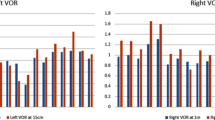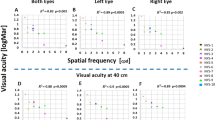Summary
Optokinetic nystagmus (OKN) was tested in 15 patients with unilateral strictly occipital brain lesions and complete homonymous hemianopia and compared with findings in a group of normal controls. Quantitative analysis of the results in the patients revealed a bilateral disorder of OKN. When the stimulus was moved in the direction opposite to the hemianopic field, there was a significant decrease in optokinetic gain, and the amplitude of nystagmus decreased. There was no correlation between OKN and size of the residual macular field.
Similar content being viewed by others
References
Baloh RW, Yee RD, Honrubia V (1980) Optokinetic nystagmus and parietal lobe lesions. Ann Neurol 7:269–276
Barany R (1921) Zur Klinik and Theorie des EisenbahnNystagmus. Arch Augenheilkd 87:139–142
Carmichael EA, Dix MR, Hallpike CS (1954) Lesions of the cerebral hemispheres and their effects upon optokinetic and caloric nystagmus. Brain 77:345–371
Cogan DG, Loeb DR (1947) Optokinetic response and intracranial lesions. Arch Neurol Psychiatr 61:183–187
Cords R (1926) Optisch-motorisches Feld and optisch-motorische Balm. Arch Ophthalmol 117:58–113
Die G van, Collewijn H (1982) Optokinetic nystagmus in man. Role of central and peripheral retina and occurrence of asymmetries. Hum Neurobiol 1:111–119
Die G van, Collewijn H (1986) Control of human optokinetic nystagmus by the central and peripheral retina: effects of partial visual field maskings, scotopic vision and central retinal scotoma. Brain Res 19:1105–1115
Gassel MM, Williams D (1963) Visual function in patients with homonymous hemianopia. II. Oculomotor mechanisms. Brain 86:1–36
Jung R, Kornhuber HH (1969) Results of ENG in man: the value of optokinetic, vestibular and spontaneous nystagmus for neurological diagnosis and research. In: Bender M (ed) The oculomotor system. Harper and Row, New York, pp 428–482
Kaga K, Suzuki JI (1982) Optokinetic pattern asymmetry in patients with cerebral lesions. In: Honrubia V, Brazier MAB (eds) Nystagmus and vertigo. Academic Press, New York, pp 279–286
Kestenbaum A (1946) Clinical methods of neuro-ophthalmologic examinations. Grune and Stratton, New York
Köjallman L, Frisen L (1986) The cerebral ocular pursuit pathway. J Clin Neuro Ophthalmol 6:209–214
Kömpf D (1986) The significance of optokinetic nystagmus asymmetry in hemispheric lesions. Neuro-ophthalmology 6:61–64
Lenz H (1941) Das Verhalten des optokinetischen Nystagmus bei einigen Fallen von Lappenresektion. Nervenarzt 14:124–126
Levenson DS, Smith JL (1966) Optokinetic nystagmus and occipital lesions. Am J Ophthalmol 61:753–762
Ohm J (1922) Die klinische Bedeutung des optischen Drehnystagmus. Klin Monatsbl Augenheilkd 68:323–355
Smith JL (1963) Optokinetic nystagmus: its use in neuroophthalmologic diagnosis. Thomas, Springfield
Smith JL, Cogan DG (1959) Optokinetic nystagmus: a test for parietal lobe lesions. Am J Ophthalmol 48:187–193
Stenvers HW (1924) Über die klinische Bedeutung des optischen Nystagmus für die zerebrale Diagnostik. Schweiz Arch Neurol Psychiatr 14:279–286
Tuna RJ, Ungerleider LG (1988) Fiber pathways of cortical areas mediating smooth pursuit eye movements in monkeys. Ann Neurol 23:174–183
Yee RD, Baloh RW, Honrubia V, Jenkins AJ (1982) Pathophysiology of optokinetic nystagmus. In: Honrubia V, Brazier MAB (eds) Nystagmus and vertigo. Academic Press, New York, pp 251–275
Author information
Authors and Affiliations
Rights and permissions
About this article
Cite this article
Kölmel, H.W., Nabel, H.J. Optokinetic nystagmus in homonymous hemianopia due to a strictly occipital lesion. Eur Arch Psychiatr Neurol Sci 238, 199–202 (1989). https://doi.org/10.1007/BF00381465
Received:
Issue Date:
DOI: https://doi.org/10.1007/BF00381465




